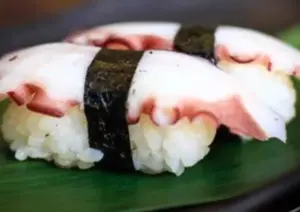Tako (Octopus)
Sushi Items – Tako (Octopus)
 Tako (Octopus) is daunting for those new to sushi or to making sushi as home. It looks strange to those unaccustomed to eating it, and when cooked, it has a rubbery, tough texture that requires slicing into thin pieces (and optimally tenderizing due to the texture) in order to be served sashimi style.
Tako (Octopus) is daunting for those new to sushi or to making sushi as home. It looks strange to those unaccustomed to eating it, and when cooked, it has a rubbery, tough texture that requires slicing into thin pieces (and optimally tenderizing due to the texture) in order to be served sashimi style.
TFako is somewhat of an anomaly in the sushi world in that it is almost always boiled before consumption in order to bring out the faint flavors of the dish, and more important to tenderize the meat (in addition to manual tenderizing by pounding the meat). It is also quite nutritious, and more data on that can be found by clicking on “The Seafood” on this UC San Diego website page and our sushi calories section on this site.
Tako As An Interesting Cooked Sushi Dish
Octopus is consumed throughout the world in a variety of dishes and styles of cooking, but somewhat unique to the food is the need for tenderizing, a process we cover in our “side dishes” section. Methods of tenderizing vary widely across the world, and often seem based more on superstition than fact (some chefs will tell you that it must be boiled in a copper pot, or that the only way to be certain is to throw it against a spotlessly clean sink exactly four times in a row).
The most common way for Japanese sushi chefs to prepare it is through a salt wash which gets rid of any remaining slime and viscera, and to then massaging it with salt and chopped daikon radish.
If this step is ignored, it may lead to a finished product that feels like you are biting into rubber. When prepared correctly, however, tako is delicious served on its own, in sushi, or in salads, with tako salad being a common side item in Japanese restaurants.
Sourcing Octopus And Its Value As Food
Tako is sourced from all over the world, with most of the product arriving from the Northwest coast of Africa. It is also commonly fished in Asian waters and the Mediterranean.
For the purposes of sushi making, and all the Japanese-style preparations, it is then almost always processed in Japan, which is the largest hub of octopus preparation, freezing, and shipping. The octopus is a short lived animal, and therefore does not accumulate high quantities of mercury the same way that large predatory fish with long life spans do.
It is also high in protein and low in fat. Nutritionally speaking, octopus is a fairly low calorie food, making it a great choice for those concerned with nutritional issues.
Tako Sushi Is A Fascinating Dish To Try
If you are able to get your hands on fresh Tako, count yourself lucky. It is a delicacy when prepared correctly, and is not as daunting as one would first think. If you do wish to try Tako sashimi, your best bet is a high quality sushi restaurant with experienced chefs where it will be sliced finely and expertly.
We do not advise trying to make tako as sushi or sashimi at home if you are not experienced, as its tough nature may make preparing it improperly, possibly hurting yourself, or end up with thick rubbery chunks that are difficult to chew. Preparing this slippery cephalopod is not for the meek.
But with practice, most can master the art of preparing this food, which is a delicious and fairly common source of protein around the world, and prepared in a variety of ways. Ours, of course, is as sushi or sashimi by a skilled sushi chef.
I have always been fascinated by the creation and culture of different foods, particularly sushi and sashimi in the modern era of Japanese cuisine. I am a classically trained chef and sushi connoisseur, also having operated a food service company and enjoy investigating and experimenting with food around the world.